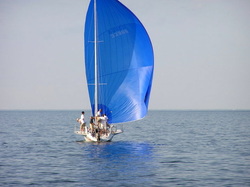Reading about accidents may give the impression that boating is a particularly dangerous sport, but remember that safe days on the water usually are not reported in the press.

The Chicago Yacht Club Race to Mackinac Island is a 333-mile race sailed on Lake Michigan. WingNuts was a Kiwi 35 sport boat (a racing sailboat), the design of which made her have low stability or resistance to capsize. The vessel was crewed by eight competent sailors. This blog post discusses only the safety lessons learned from the accident, not the suitability of the yacht’s design, which is analyzed in the full report.
Around 2300 local time, “during a thunderstorm with winds in the range of 50kn and waves of 4-6ft/1-2m, the boat was blown over and capsized, turning turtle. There was no time to send a distress signal. Five members of the eight-man crew were able to release themselves from the vessel, one was able to swim out of the cabin to the surface, and two were unable to do so and died. The Coroner’s report lists head injuries as the cause of death. The two fatalities very likely occurred within a few minutes of the capsize . . . as these sailors were helpless due to their injuries.” These were the first deaths in a sailing accident in the 103-year history of this race. Aided by the personal lights and whistles of the surviving crewmembers, Sociable, a 40ft competing sailboat with a crew of 12, rescued the six survivors, who were standing on and clinging to the overturned hull. At the same time, communications with the Coast Guard were established by Sociable and other yachts, and the CG became involved in the rescue.
Lessons learned:
“While the Chicago-Mac racers are required to carry either a life raft or an EPIRB, it was two SPOT Personal Satellite Messengers that first alerted the families and the Coast Guard to the trouble on WingNuts. [Two persons] each carried the small satellite communicator and each activated their SPOT after the capsize. This proved to be an effective means of alerting their parents and the Coast Guard, within a few minutes, via services provided by SPOT and [the] GEOS [satellite system].”
In addition to SPOT, other non-traditional forms of communication were used during the storm and rescue, including cell phone calls, text messages, and Facebook.
Boaters should be as vigilant about possible about impending severe weather events so they can prepare. The approach of severe local weather at night may be particularly difficult to ascertain, without having several means of receiving weather information, and sometimes localized severe weather may arrive so rapidly that there’s almost no time to take action.
The report from Sociable about their rescue efforts has some good information:
- The Lifesling man overboard system was the key to a prompt rescue.
- Other safety gear used included a throw rope, parachute and handheld flares, spotlight, and a first aid kit.
- The whistles and lifejacket lights on the crew of WingNuts enabled Sociable to find the sailors in the middle of a dark night.
- The crew of Sociable had participated in an annual man overboard certification practice. They also held a pre-race safety briefing and quiz so the crewmembers knew where all safety equipment was stowed, enabling prompt action.
- There were enough people on Sociable to separate radio communications from the rescue efforts, allowing two separate groups to concentrate on their jobs.
- Other racing boats created an immediate search party for the two missing crewmembers. Approximately 24 boats participated.
Mackinac Capsize and Fatalities, see http://about.ussailing.org/US_SAILING_Meetings/USS_Reports.htm. There are many interesting and instructive details. [The quotations above are from this report.] The WingNuts photo was taken by Mark Morley.
 RSS Feed
RSS Feed